- Return to Article Of The Month index
Identification of Fall Pasture Insect Pests
August 2001
Jim Selph - DeSoto County Extension, Director/Livestock Agent
As we approach the end of Summer,it is time to begin to think about the insect pests that we normally have to deal with, beginning in August, each year. Those insects normally are: Fall Armyworms and Spittle Bugs.
Spittle Bug
The Spittle Bug (Prosapia bicincta) is an insect with piercing/sucking mouthparts, that inject toxic juices into the plant. Forages that are particularly susceptible are Bermuda, Limpograss, Pangola, and Rhodesgrass. Adults of the two-lined spittlebug have the characteristic leafhopper shape and are dark brown to black with red legs and eyes. It gets its name from the conspicuous two red to orange lines across its wings.
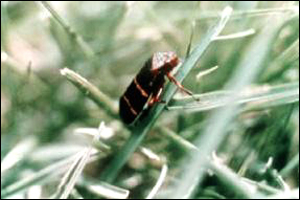
Spittle Bug (Prosapia bicincta)
Nymphs are cream-colored with brown heads and eyes. They produce a white, frothy mass that completely hides them as they feed. These nymphs can usually be found in the crowns of the grass by digging down into the grass at soil level. During the summer, eggs hatch in 15-19 days and the nymphs begin feeding and producing the frothy mass immediately. Nymphs feed for 30-50 days before molting into the adult stage. On average, each adult female lays 45 eggs. There are two and occasionally three generations a year in Florida.
Damage Causes Leaf Burn (Yellow Tips) and Dieback. Leaves will show streaking or stippling and sometimes complete loss of stand can occur.
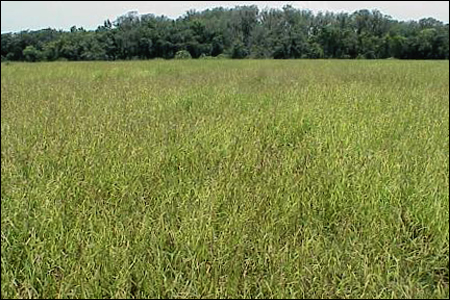
When walking through a grass field such as this limpo, observe for small dark insects that seem to dart away from you as you move through the field. A close up view of the crown of the grass will reveal the spittle mass and the immature larvae of the spittlebug.
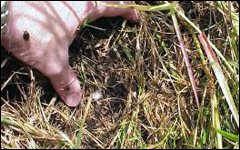
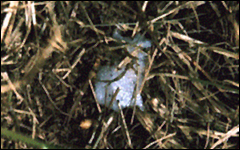
Fall Armyworm
The Fall Armyworm (Spodoptera frugiperda) is native to the tropical regions of the western hemisphere from the United States to Argentina. It normally overwinters successfully in the United States only in southern Florida and southern Texas. The fall armyworm is a strong flier, and disperses long distances annually during the summer months. It is possible for the moth to move distances as great as 300 miles. The Generation interval in Florida through late Spring, Summer and early Fall is about every 30 days, with the peak months being June through September.
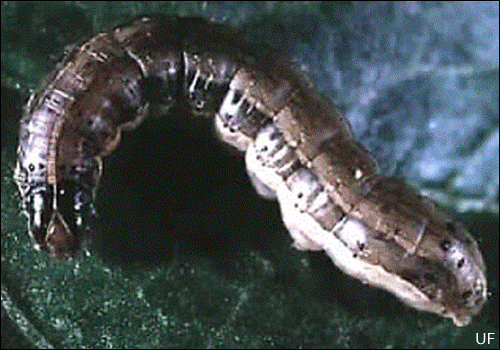
By observing the head, you should be able to identify it as an Armyworm by the inverted "V".
The egg is dome shaped; the base is flattened and the egg curves upward to a broadly rounded point at the apex. The egg measures about 0.4 mm in diameter and 0.3 m in height. The number of eggs per mass varies considerably but is often 100 to 200, and total egg production per female averages about 1500 with a maximum of over 2000.
Pupation normally takes place in the soil, at a depth 2 to 8 cm. The larva constructs a loose cocoon, oval in shape and 20 to 30 mm in length, by tying together particles of soil with silk. Duration of the pupal stage is about eight to nine days during the summer, but reaches 20 to 30 days during the winter in Florida.
The moths has a wingspan of 32 to 40 mm. In the male moth, the forewing generally is shaded gray and brown, with a triangular white spots at the tip and near the center of the wing. The forewings of females are less distinctly marked, ranging from a uniform grayish brown to a fine mottling of gray and brown. The hind wing is iridescent silver-white with a narrow dark border in both sexes.

Eggs Male Female
Monitor or walk through pastures on a regular basis. The threshold is 2 to 3 worms per square foot. If control is attempted, the best time is when the worms are ½ inch or less in length. When we find a field that the worms are 1¼ inches in length, spraying will not be a viable option. Adult moths are most active during warm humid evenings.

